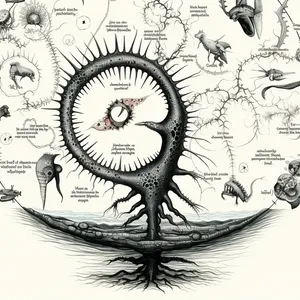
Unclassified: Life Forms Beyond Categorisation
In our animal kingdom, there exist creatures so baffling and challenging to align within established taxonomic groups that they seem akin to nature's mischievous experiments or jests. These unclassifiable beings have intrigued biologists, leading to both unclassified species and chimerical creatures spawned by the exploration of scientists and artists. A genetic chimera amalgamates materials from multiple sources, a concept scientists propose for solving medical predicaments and saving lives. CRISPR researchers suggest growing human organs within animals using the recipient's cells, facilitating transplantation for individuals in need. Animal hybrids are also investigated for potential novel cancer treatments. Mythologically, the chimera embodies an entity composed of multiple animal parts, evident in centaurs, griffins, and present in various religious beliefs, such as Vishnu in Hinduism. Advancements in bioengineering accelerate beyond regulatory frameworks. Human-animal hybrid embryos were announced, sparking ethical debates. Meanwhile, contemporary artists engage in envisioning chimeras of the future through their work. In Techno-Bestiary series Mariia Fedorova tells a story of small cyborgized creatures stuck in an outer space in silent interaction with space objects such as cyborg wolf pack, crows and moon, lily pollinated by satellites, horse in a golden helmet. Jenia Filatova, an artist who works with mixed media for mixed feelings, always challenges the norm, Jenia is combining the unpredictablу: from aliens, floral and animal hybrids, non-existing Frankenstein creatures to mutants, by asking: what does it mean to alter nature’s evolution and what is humanness if we can customize people with animal features? In Chthulucene video Jiabao Li imagines the world centered around octopuses but not humans where global warming causes sea levels to rise, all continents are submerged underwater and the world becomes a playground for the infinite interspecies metamorphosis. Wendi Yan's Tale of the Mammoth Goddess tells the story of a resurrected mammoth who escaped from the Pleistocene Park and hides in a coal mine to prepare for her natural death. Yan imagines a mammoth that was resurrected with human’s frontier biotechnology to save the tundra ecosystem, but who escapes duty imposed on her to live a life she wants for herself: one in which she dies naturally amidst memories of her ancestors. Joey Holder presents the showcase of cryptids, creatures which may or may not exist, unrecognised by mainstream science. An astonishing 86% of all plants and animals on land and 91% of those in the seas have yet to be named and catalogued. With the majority of life in the sea unmapped, unobserved, and unexplored there are millions of ‘Cryptids’ out there, the artist specculates on these creatures alongside those that have been ‘captured’ and catalogued by mankind by creating a map of creatures which are ‘off-limits’, made-up, or undiscovered. Amidst rising activism against animal cruelty in various sectors, scientific and technological advancements raise hopes and concerns. Gene-editing of human embryos sparks ethical dilemmas, urging legal and public scrutiny. Art-laboratory studios experiment to anticipate future developments, initiated by Eduardo Kac, renowned for transgenic art—creating Alba, a living rabbit genetically modified using jellyfish DNA in collaboration with geneticist Louis-Marie Houdebine. Kac asserts that new technologies redefine our perception of the human body, transitioning it from a naturally regulated system to an electronically transformed object, evident in media representations, virtual realities, and medical technologies like plastic surgery and neuroprosthesis. Transgenic art emerges as a form incorporating genetic engineering to produce unique living beings, fostering a dialogue between artist, public, and transgenic organisms. With an endangered species becoming extinct daily, artists contributing to global biodiversity through invention hold significance. Ethical considerations become paramount in transgenic art, emphasizing responsibility for the new life form created and advocating for a dialogical relationship between all involved parties. Speculative artworks create spaces to address socio-political issues, explore possibilities, and envision futures akin to science fiction. They challenge our evolving relationships with animals and plants, offering foresight into potential changes while reflecting our aspirations and anxieties for the future.








